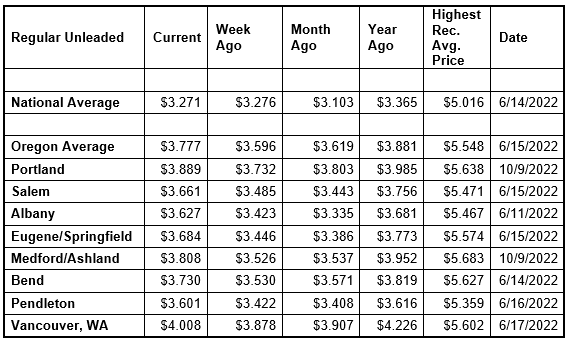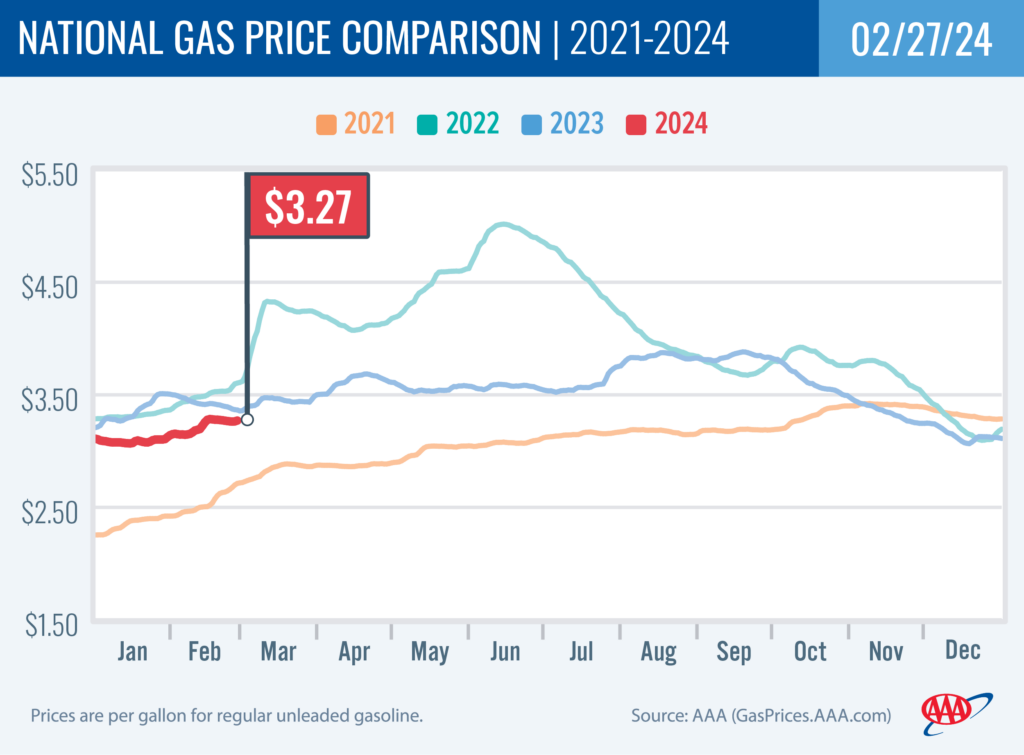PORTLAND, Ore., – Atmospheric rivers in California, refinery maintenance and the switch to summer-blend fuel in Northern California are sending pump prices higher on the West Coast. But the national average is fairly steady this week after increasing for the last month. For the week, the national average for regular ticks down half a cent to $3.27 a gallon. The Oregon average soars 18 cents to $3.78 a gallon. This is the largest week-over-week gain for a state in the nation.

This is the time of year for the seasonal climb in gas prices due to refinery maintenance and the switch to EPA-mandated summer-blend fuel. California switches earlier than other states, and as a result, supplies have tightened in the West Coast region. In addition, there were some planned and unplanned flaring incidents at the Carson section of Marathon Petroleum’s facility in Los Angeles that normally produces 382,000 barrels a day. Flaring serves to de-pressurize equipment by burning excess gas. This work is expected to wrap up by March 1.
“Wholesale prices have shot up on the West Coast due to the temporary crimp in supplies. These increases are being passed on to consumers. We can expect volatile pump prices for the next few weeks. The West Coast often sees prices rise earlier than other parts of the country, since California switches to summer-blend fuel earlier than other areas,” says Marie Dodds, public affairs director for AAA Oregon/Idaho.
All counties in Oregon except Curry ($4.13) have averages below $4 a gallon. The Oregon average began 2024 at $3.79 a gallon compared to $3.78 today. The national average started the year at $3.11 and is at $3.27 today.
Gas prices normally rise in the first and second quarters of the year. The factors include refinery maintenance season, the normal seasonal growth in demand, and the federally mandated switch from winter-blend fuel to summer-blend, which is more expensive to produce. Summer-blend gas helps reduce emissions from gasoline during the warm summer months. More info on summer- and winter-blend gasoline can be found at the EPA website.
Crude oil prices declined a little last week, largely due to talk of a possible ceasefire between Israel and Hamas. West Texas Intermediate climbed to $79 on February 16, the highest price since Nov. 6. Crude prices have been volatile since the attack on Israel by Hamas in October. While Israel and the Palestinian territory are not oil producers, there’ve been concerns that the conflict could spread in the Middle East, which could potentially impact crude production in other oil-producing nations in the region.
Crude oil is trading around $78 today compared to $78 a week ago and $76 a year ago. In 2023, West Texas Intermediate ranged between $63 and $95 per barrel. Crude reached recent highs of $123.70 on March 8, 2022, shortly after the Russian invasion of Ukraine, and $122.11 per barrel on June 8, 2022. The all-time high for WTI crude oil is $147.27 in July 2008.
Crude oil is the main ingredient in gasoline and diesel, so pump prices are impacted by crude prices on the global markets. On average, about 56% of what we pay for in a gallon of gasoline is for the price of crude oil, 8% is refining, 19% distribution and marketing, and 16% are taxes, according to the U.S. Energy Information Administration.
Demand for gas in the U.S. increased slightly from 8.17 to 8.20 million b/d for the week ending February 16, according to the U.S. Energy Information Administration (EIA). This compares to 8.91 million b/d at the same time last year. Meanwhile, total domestic gasoline stocks declined slightly by 300,000 bbl to 247 million bbl.
Flat demand, amid falling supply, has helped to stabilize the national average this week.
Quick stats
Oregon is one of 24 states with higher prices now than a week ago. Oregon (+18 cents) has the largest week-over-week gain in the nation. Ohio (-13 cents) has the biggest weekly drop. Washington (+13 cents) and Idaho (+11 cents) have the second- and third-largest weekly jumps. The averages in New York and Kentucky are flat.
Hawaii ($4.71) has the most expensive gas in the nation for the eighth week in a row. California ($4.65) is second, and Washington ($4.04) is third. These are the only three states with averages at or above $4, up from two states a week ago. This week 34 states and the District of Columbia have averages in the $3-range. Thirteen states have averages in the $2 range this week.
The cheapest gas in the nation is in Mississippi ($2.85) and Oklahoma ($2.87). No state has had an average below $2 a gallon since January 7, 2021, when Mississippi and Texas were below that threshold.
The difference between the most expensive and least expensive states is $1.86 this week, same as a week ago.
All 50 states have higher prices now than a month ago. The national average is 17 cents more and the Oregon average is 16 cents more than a month ago. This is the 29th largest monthly gain in the nation. Utah (+47 cents) has the largest monthly increase.
Oregon is one of 42 states and the District of Columbia with lower prices now than a year ago. The national average is 10 cents less and the Oregon average is 10 cents less than a year ago. Colorado (-$1.11) has the largest yearly decrease. Maryland (+13 cents) has the largest year-over-year increase.
West Coast
The West Coast region continues to have the most expensive pump prices in the nation with all seven states in the top 10. It’s typical for the West Coast to have six or seven states in the top 10 as this region tends to consistently have fairly tight supplies, consuming about as much gasoline as is produced. In addition, this region is located relatively far from parts of the country where oil drilling, production and refining occurs, so transportation costs are higher. And environmental programs in this region add to the cost of production, storage and distribution.
| Rank | Region | Price on 2/27/24 |
| 1 | Hawaii | $4.71 |
| 2 | California | $4.65 |
| 3 | Washington | $4.04 |
| 4 | Nevada | $3.92 |
| 5 | Oregon | $3.78 |
| 6 | Alaska | $3.54 |
| 7 | Pennsylvania | $3.51 |
| 8 | Illinois | $3.50 |
| 9 | District of Columbia | $3.43 |
| 10 | Arizona | $3.38 |
As mentioned above, Hawaii has the most expensive gas in the country for the eighth week in a row. California, Nevada, Washington, Oregon, and Alaska round out the top six. Arizona is 10th. Oregon is fifth most expensive for the 19th week in a row.
All seven states in the West Coast region are seeing week-over-week increases: Oregon (+18 cents) has the largest increase in the region and the country. Washington (+13 cents) has the second-largest increase in the region and the country. Alaska (+9 cents), Hawaii (+2 cents), Nevada (+2 cents), Arizona (+2 cents) and California (+1/2 cent) also have week-over-week increases.
The refinery utilization rate on the West Coast fell from 76.4% to 74.7% for the week ending February 16. This rate has ranged between about 73% to 96% in the last year. The latest national refinery utilization rate held steady at 80.6% for the second consecutive week.
According to EIA’s latest weekly report, total gas stocks in the region fell from 31.96 million bbl. to 31.92 million bbl.
A lower refinery utilization rate and a decrease in gasoline stocks can put upward pressure on pump prices.
Oil market dynamics
Crude oil prices have eased a little since climbing to $79 on February 16. Talk of a possible ceasefire between Israel and Hamas sent prices lower, but they have rebounded this week over uncertainty on a potential truce. And continuing attacks in the Red Sea continue to put upward pressure on prices as concerns remain that shipping routes will be hindered as hostilities continue. Also, the EIA reported that total domestic commercial crude stocks increased by 3.6 million bbl to 443 million bbl last week.
At the close of Friday’s formal trading session, WTI fell $2.12 to settle at $76.49. At the close of Monday’s formal trading session, WTI rose $1.09 to close at $77.58. Today crude is trading around $78 compared to $78 a week ago. Crude prices are about $1 more than a year ago.
Drivers can find current gas prices along their route with the free AAA Mobile app for iPhone, iPad and Android. The app can also be used to map a route, find discounts, book a hotel and access AAA roadside assistance. Learn more at AAA.com/mobile.

Diesel
For the week, the national average slips two cents to $4.07 a gallon. The record high is $5.816 set on June 19, 2022. The Oregon average adds four cents to $4.18. The record high is $6.47 set on July 3, 2022. A year ago the national average for diesel was $4.41 and the Oregon average was $4.73.
Find current fuel prices at GasPrices.AAA.com.
AAA news releases, high resolution images, broadcast-quality video, fact sheets and podcasts are available on the AAA NewsRoom at NewsRoom.AAA.com.
Find local news releases at https://oregon.aaa.com/community/media/media-contacts.html
Fuel prices are updated daily at AAA’s Daily Fuel Gauge at AAA Gas Prices. For more info go www.AAA.com. AAA Oregon/Idaho provides more than 890,000 members with travel, insurance, financial and automotive-related services, and is an affiliate of AAA National, serving more than 64 million motorists in North America.

